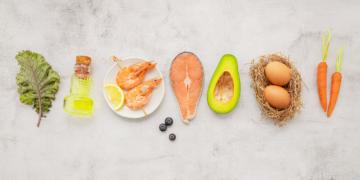Introduction to Tomato Varieties
Tomatoes are one of the most popular and versatile crops grown by gardeners worldwide. From their sweet and juicy flavors to their vibrant colors, tomatoes come in an array of shapes, sizes, and tastes. Whether you prefer snacking on small cherry tomatoes, cooking up rich tomato sauces, or slicing large, meaty beefsteak tomatoes, there’s a variety to suit your needs. Selecting the right type of tomato for your garden cannot only enhance your yields but also improve the flavor of your harvest.
“If you’re new to gardening and want to start with simple crops, check out our guide on easy vegetables to grow for a thriving backyard garden.”
Understanding tomato varieties is essential for choosing the best types based on your specific goals, whether you’re looking for tomatoes to eat fresh, preserve, or cook. This guide will help you explore different categories of tomatoes, their growing requirements, and the best varieties to consider for a thriving garden.

Determinate vs. Indeterminate Tomatoes: What’s the Difference?
Before diving into specific tomato varieties, it’s important to understand the two primary growth habits: determinate and indeterminate.
Determinate Tomatoes, often referred to as “bush tomatoes,” grow to a set size and produce all their fruit in a short window of time. These varieties are perfect if you’re looking for a large harvest all at once, making them ideal for canning or cooking in bulk. Once the fruits ripen, the plant stops growing.
On the other hand, Indeterminate Tomatoes are vining varieties that continue growing and producing fruit throughout the season. These plants require staking or caging due to their continuous growth and are perfect if you want a steady supply of fresh tomatoes from early summer until the first frost.
Understanding the difference between these two growth types will help you choose the right variety depending on your gardening space, climate, and harvest preferences.
Heirloom vs. Hybrid Tomatoes: Which Should You Choose?
When selecting tomato varieties, you’ll often come across the terms heirloom and hybrid. Both types have their unique advantages, and choosing between them largely depends on your priorities as a gardener.
Heirloom Tomatoes are open-pollinated varieties that have been passed down through generations. They are prized for their distinct flavors, unusual shapes, and wide range of colors. Many gardeners grow heirloom tomatoes for their rich, complex flavors and unique appearance, though they may require more attention as they tend to be less disease-resistant than hybrid varieties.
Hybrid Tomatoes, on the other hand, are cross-bred to achieve specific traits, such as improved disease resistance, higher yield, or consistent size. While hybrids may not always have the depth of flavor that heirlooms are known for, they offer reliability and resilience, making them a great choice for gardeners who prioritize ease of growth and productivity.
“For a detailed guide on tomato classifications, see this resource from the University of California Agriculture and NaturalResources.”
Top 5 Cherry Tomatoes for Sweetness and Yield
Cherry tomatoes are beloved for their small size, sweetness, and high productivity. These bite-sized fruits are perfect for snacking, salads, and even roasting. Whether you’re an experienced gardener or just starting out, cherry tomatoes are an excellent choice because they’re easy to grow and produce abundant fruit throughout the season.

“Cherry tomatoes are one of the easiest varieties to grow, even for beginners. For more easy-to-grow vegetable options, see our list of 10 easy vegetables for a backyard garden.”
Here are five of the top cherry tomato varieties known for their sweetness and yield:
- Sun Gold: Famous for its tropical sweetness, Sun Gold is an indeterminate variety that produces bright orange fruits all season long. It’s considered one of the sweetest cherry tomatoes available.
- Sweet 100: This classic red cherry tomato is known for its high sugar content and can produce hundreds of small fruits on indeterminate vines, making it a prolific producer.
- Black Cherry: With its deep purplish-red color and rich, smoky flavor, Black Cherry offers a gourmet twist to traditional cherry tomatoes, perfect for salads or roasting.
- Gardener’s Delight: A reliable variety, Gardener’s Delight produces an abundance of sweet, bright red tomatoes that are excellent for both fresh eating and cooking.
- Yellow Pear: This heirloom variety has a mild, sweet flavor with a unique pear shape. It produces small, yellow fruits and is ideal for adding a pop of color to salads.
Growing Tips: Most cherry tomato varieties are indeterminate, meaning they will need support from stakes or cages. Ensure they receive full sun (6-8 hours daily) and regular watering to encourage high yields. These varieties grow well in both garden beds and containers, making them versatile options for any space.
Best Grape Tomatoes for Snacking and Storage
Grape tomatoes are similar to cherry tomatoes in size but tend to have a firmer texture and thicker skin. This makes them ideal for snacking, storing, and even cooking. Grape tomatoes have a longer shelf life compared to their juicier cherry counterparts, making them a popular choice for both fresh eating and meal prep.

Here are some top grape tomato varieties to consider:
- Red Grape: Known for its crisp texture and mildly sweet flavor, this variety is perfect for salads and snacking. It’s a prolific producer and stores well after harvest.
- Juliet: Often described as a mini Roma tomato, Juliet is oblong in shape and meaty, making it great for sauces as well as fresh eating. This hybrid variety is resistant to cracking and highly productive.
- Yellow Pear: While classified as both a cherry and grape tomato, Yellow Pear offers a mild sweetness and bright yellow color, perfect for adding a visual and flavorful touch to any dish.
Differences Between Cherry and Grape Tomatoes: While both types are small and snackable, the primary difference lies in their texture and storage. Cherry tomatoes are rounder and juicier, while grape tomatoes have a thicker skin and firmer texture, allowing them to last longer and resist bursting during cooking.
Beefsteak Tomatoes for Slicing and Sandwiches
Beefsteak tomatoes are known for their large size, meaty texture, and juicy flesh, making them ideal for slicing. These tomatoes are commonly used in sandwiches, burgers, and salads due to their rich flavor and substantial size.
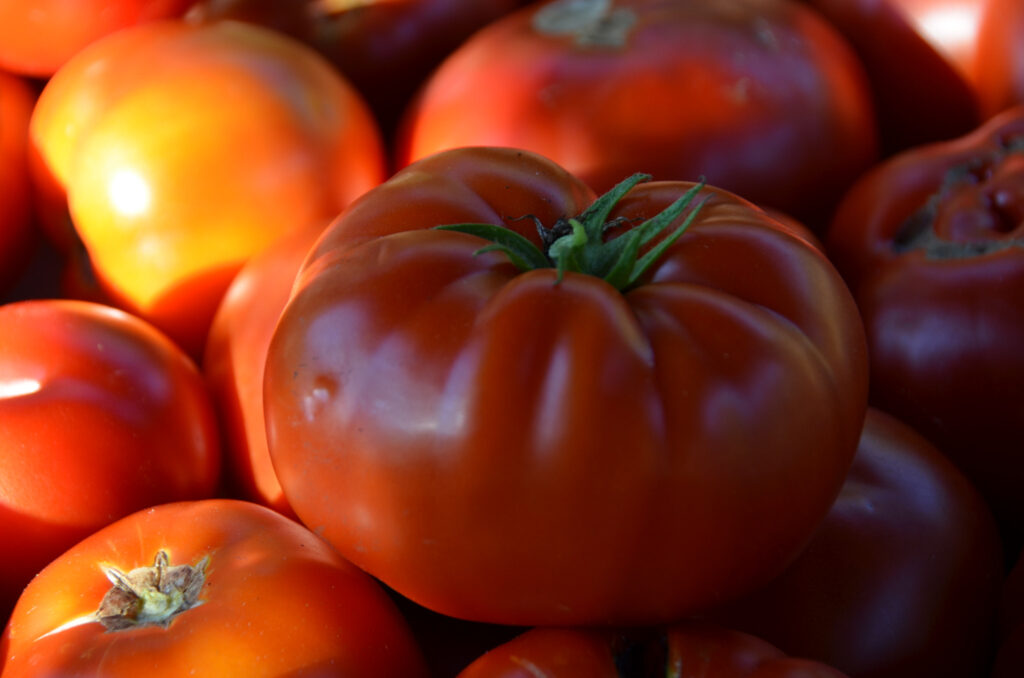
Here are some of the best beefsteak tomato varieties:
- Big Beef: This hybrid variety is a garden favorite due to its disease resistance and reliable growth. Big Beef tomatoes are large, red, and full of flavor, making them perfect for slicing and eating fresh.
- Brandywine: One of the most popular heirloom varieties, Brandywine produces large, pinkish-red tomatoes with a rich, robust flavor. It’s known for its incredible taste but can be finicky to grow.
- Mortgage Lifter: This heirloom tomato is prized for its large size (up to 2 pounds) and mild, sweet flavor. It’s a heavy producer and makes a great addition to sandwiches and salads.
Growing Tips for Beefsteak Tomatoes: Due to their large fruit size, beefsteak tomatoes need strong support. Indeterminate in nature, they grow throughout the season and require regular pruning to improve airflow and prevent disease. They thrive in full sun and require consistent watering to prevent cracking.
Roma (Plum) Tomatoes for Cooking and Sauces
Roma tomatoes, also known as plum tomatoes, are favored for their dense, meaty flesh and low water content, making them the perfect choice for cooking, especially for sauces, pastes, and canning. Their compact structure means fewer seeds and more flesh, contributing to their thick texture when cooked.
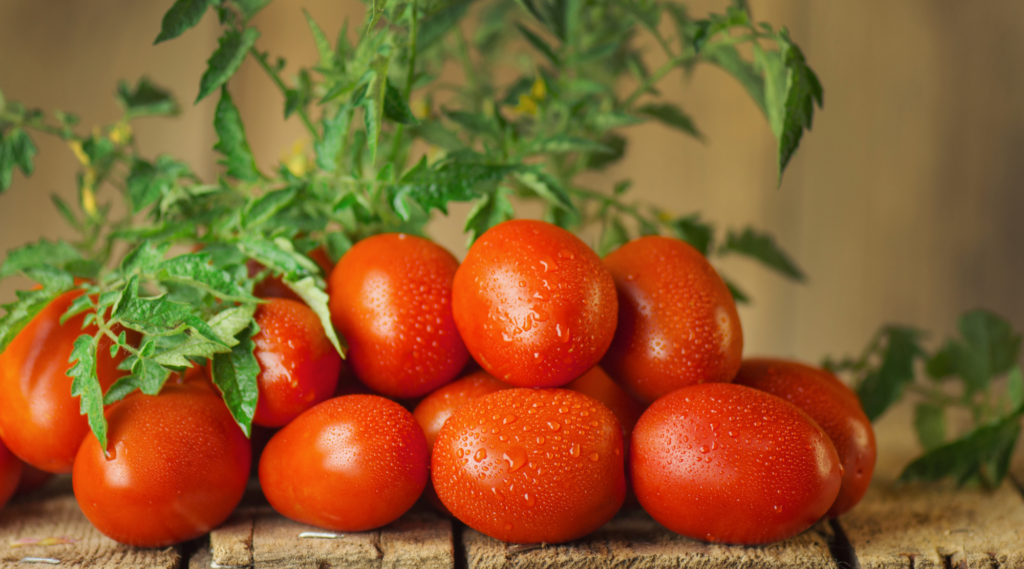
Here are some of the best Roma tomato varieties:
- San Marzano: Considered the gold standard for sauce-making, San Marzano tomatoes hail from Italy and are renowned for their rich, slightly sweet flavor and low acidity. Their firm, fleshy texture makes them ideal for creating smooth, flavorful sauces.
- Amish Paste: This heirloom variety produces large, meaty tomatoes with a complex, sweet flavor. Amish Paste tomatoes are excellent for sauces, pastes, or even fresh eating due to their versatile nature.
- La Roma: A reliable hybrid, La Roma is bred for disease resistance and uniformity, making it a favorite for home gardeners who want a hassle-free, productive tomato for canning and cooking.
Best Uses for Roma Tomatoes: Due to their low moisture content, Roma tomatoes are ideal for making sauces, salsas, and pastes. They hold up well during long cooking processes and are also perfect for roasting with herbs and olive oil.
Heirloom Tomatoes for Unique Flavors and Colors
Heirloom tomatoes are prized for their distinct flavors, unusual shapes, and a rainbow of colors. Unlike hybrid varieties, heirlooms are open-pollinated and have been passed down through generations, often valued for their unique appearance and taste rather than their resistance to disease. Growing heirlooms can be a bit more challenging, but their reward in flavor and beauty makes them worth the extra effort.
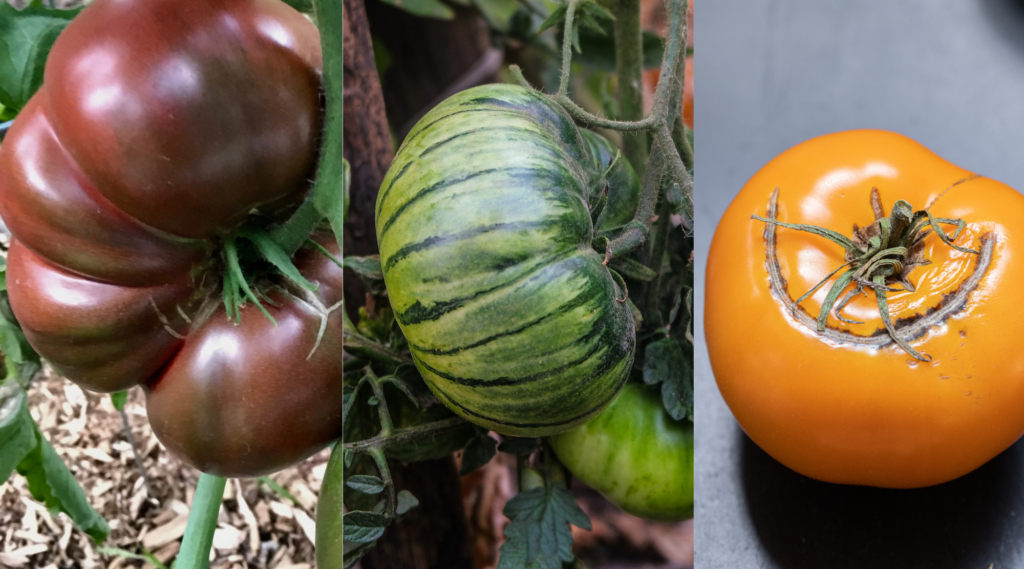
Here are some standout heirloom varieties:
- Cherokee Purple: With its deep, purplish-red color and rich, slightly smoky flavor, Cherokee Purple is a favorite among heirloom enthusiasts. Its unique color and savory taste make it perfect for salads and gourmet dishes.
- Green Zebra: Known for its striking green and yellow striped skin, Green Zebra tomatoes have a tangy, slightly tart flavor, which adds a refreshing bite to fresh dishes.
- Yellow Brandywine: A yellow variation of the famous Brandywine tomato, this variety offers a sweet, fruity flavor and large, meaty fruits. It’s perfect for slicing and using in sandwiches or salads.
Growing Tips for Heirloom Tomatoes: Heirloom varieties are generally indeterminate and require strong support, as they grow long and heavy vines. They may also be more susceptible to pests and diseases, so it’s essential to monitor them closely and apply organic pest control methods when needed. Despite their delicacy, heirlooms are cherished for their unmatched flavor and appearance.
Paste Tomatoes: Ideal Varieties for Canning
Paste tomatoes are bred specifically for processing and preservation. These tomatoes are meaty, with very little juice, which makes them ideal for making sauces, pastes, and canned goods. Their flesh is dense, and they have fewer seeds compared to other varieties, making them the go-to choice for chefs and home gardeners who want a tomato with intense flavor and a thick texture.
Popular paste tomato varieties include:
- Amish Paste: As mentioned earlier, this heirloom variety is a large, versatile tomato that is perfect for sauces, pastes, and canning. Its sweet, rich flavor makes it a top choice for both fresh eating and cooking.
- Opalka: A long, sausage-shaped tomato that’s perfect for sauce-making. Opalka tomatoes have very few seeds and a concentrated flavor, making them an excellent choice for those looking to make thick, flavorful tomato sauces.
- Big Mama: A hybrid variety that produces large paste tomatoes, ideal for making sauces in large batches. Its meaty texture and mild, sweet flavor make it a productive and reliable option for gardeners.
Best Uses for Paste Tomatoes: Due to their dense flesh and low water content, paste tomatoes are ideal for making tomato sauces, pastes, and salsas. They can also be canned for long-term storage, ensuring you have fresh tomato flavor throughout the year.
Oxheart Tomatoes for Large, Meaty Fruits
Oxheart tomatoes are distinctive for their heart-shaped appearance and large, meaty fruits. They tend to have a slightly sweet, rich flavor and are excellent for slicing, cooking, and canning. The size and texture of oxheart tomatoes make them versatile, perfect for those looking for a substantial tomato that’s not as watery as other large varieties.
Here are some popular oxheart tomato varieties:
- Hungarian Heart: A large, pinkish-red oxheart tomato with a sweet, robust flavor. Known for its size and meaty flesh, it’s excellent for slicing and using in sauces or salads.
- Anna Russian: This pink heirloom oxheart tomato has a mild, sweet flavor and smooth texture, making it ideal for fresh eating and sandwiches.
- Bull’s Heart: A traditional Russian oxheart variety, Bull’s Heart produces large, fleshy tomatoes that are perfect for slicing, canning, or cooking.
Growing Tips for Oxheart Tomatoes: Oxheart tomatoes are indeterminate, meaning they require staking or caging to support their heavy vines. Ensure they receive full sun and consistent watering to encourage healthy fruit development. Due to their size, these tomatoes can weigh down the plant, so pruning is essential to maintain airflow and prevent disease.
Specialty Tomato Varieties for Unique Flavors and Colors
For gardeners looking to grow something beyond the traditional red tomato, specialty tomato varieties offer a wide range of unique flavors, colors, and shapes. These tomatoes not only add variety to your garden but also bring excitement and visual appeal to your dishes.
Here are some standout specialty tomato varieties:
- Striped Varieties: Tomatoes like Tigerella and Green Zebra are visually stunning with their distinct stripes. Tigerella features red and yellow striping, offering a mildly tangy flavor, while Green Zebra’s tangy, tart taste complements its striking green-and-yellow appearance.
- Yellow and Orange Varieties: Varieties such as Sun Gold and Lemon Boy bring a sweet, fruity flavor to the table with their bright yellow or orange skin. These tomatoes are perfect for adding a pop of color to salads or sauces.
- Black and Purple Tomatoes: Varieties like Black Krim and Indigo Rose are known for their deep, rich color and bold, smoky flavors. Black Krim has an earthy, slightly salty flavor, while Indigo Rose is a high-antioxidant variety that turns a stunning deep purple.
Growing Tips for Specialty Tomatoes: Specialty tomatoes often have similar growing requirements to standard varieties but may need extra care when it comes to pest and disease management. Make sure to plant them in nutrient-rich soil with plenty of sunlight. Specialty varieties can add diversity to your garden and meals, offering exciting alternatives to traditional tomatoes.
Essential Growing Tips for All Tomato Varieties
Regardless of the tomato varieties you choose, there are some essential growing practices that will ensure a bountiful and healthy harvest. Tomatoes are relatively easy to grow, but they do require specific conditions to thrive.
- Soil Preparation and Fertilization: Tomatoes grow best in well-drained, nutrient-rich soil with a pH between 6.0 and 6.8. To give your plants the best start, incorporate compost or organic matter into the soil before planting. During the growing season, a balanced fertilizer high in phosphorus will promote strong root development and fruit production.
- Ideal Watering and Sunlight Requirements: Tomatoes need consistent watering, especially during the fruit development stage. Water deeply but avoid overwatering to prevent root rot. Tomatoes require at least 6-8 hours of direct sunlight each day to flourish, so be sure to plant them in a sunny spot.
- Supporting Indeterminate Varieties: If you’re growing indeterminate varieties, make sure to provide adequate support with stakes, cages, or trellises. These varieties can grow tall and heavy, so proper support will prevent the plants from collapsing under the weight of the fruit. Regularly prune your plants by removing suckers to improve airflow and direct energy toward fruit production.
“To maximize your tomato yields and promote garden health, consider companion planting with perennial herbs. Discover the best perennial herbs for a thriving garden.”
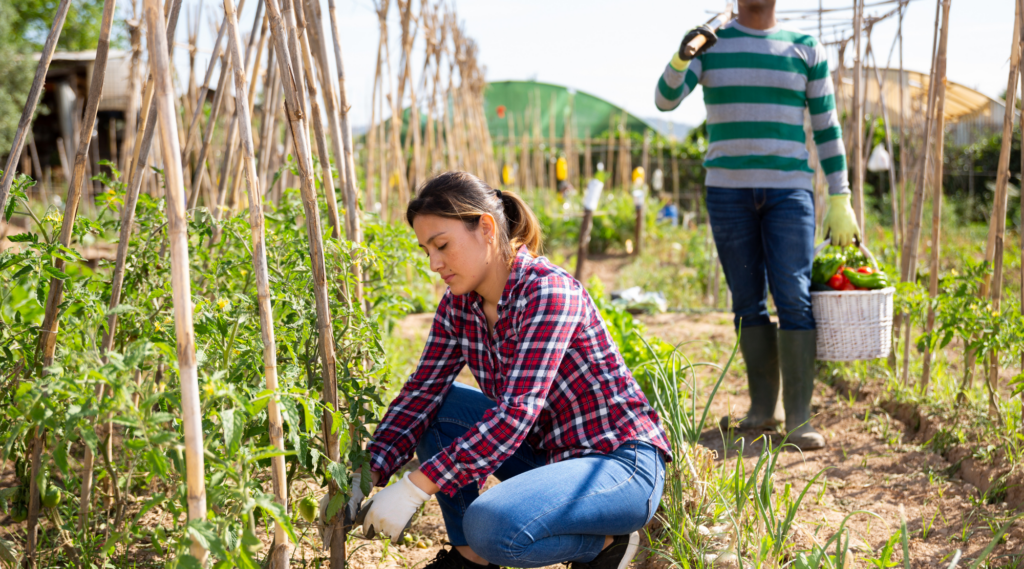
Preventing Common Tomato Growing Challenges
Growing tomatoes can come with its share of challenges, from pests to diseases and environmental stressors. Understanding how to prevent and address these common issues can help ensure a bountiful harvest.
- Pest and Disease Management: Tomatoes are vulnerable to various pests such as aphids, tomato hornworms, and whiteflies. Organic solutions like neem oil, insecticidal soap, and beneficial insects (like ladybugs) can help keep these pests in check. Common diseases such as blight, wilt, and powdery mildew can be managed by crop rotation, proper spacing for airflow, and using disease-resistant varieties.
“Companion planting can help naturally deter pests and improve plant health. Learn more about the best herbs for companion planting in our ultimate companion planting guide.”
- How to Prevent Cracking, Blossom End Rot, and Splitting: Uneven watering can lead to fruit cracking or splitting, so it’s important to maintain consistent moisture levels. Blossom end rot, which causes sunken dark spots at the bottom of the fruit, is often due to a calcium deficiency or inconsistent watering. To prevent this, amend your soil with calcium-rich additives like crushed eggshells or bone meal and water consistently.
- Pruning and Maintaining Airflow: Proper pruning of your tomato plants, especially indeterminate varieties, will improve airflow and help reduce the risk of disease. Removing lower leaves that touch the soil and regularly pruning “suckers” (the shoots that grow between the main stem and branches) will ensure the plant focuses its energy on fruit production.
“For a more extensive guide on managing common tomato pests and diseases, visit Penn State Extension.”
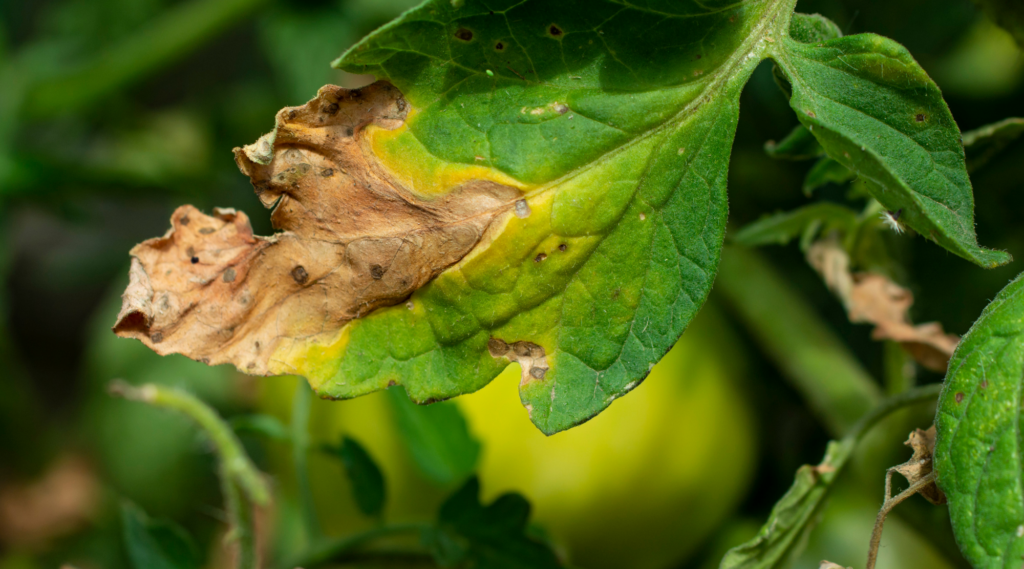
Conclusion: Choosing the Best Tomato Variety for Your Garden
With so many diverse tomato varieties available, you can easily find the perfect match for your garden’s specific needs, climate, and your personal culinary preferences. Whether you’re seeking small, sweet cherry tomatoes for fresh salads, meaty Roma tomatoes for sauces, or unique heirloom varieties with complex flavors, there’s a tomato variety out there to suit every gardener.
By selecting the right types for your garden space and caring for them properly, you can enjoy a rich, flavorful, and bountiful harvest of homegrown tomatoes all season long. Don’t be afraid to experiment with different varieties to discover new favorites, and remember to apply best practices for soil preparation, watering, and pest management to keep your plants thriving.
“For even better results, consider growing your tomatoes alongside perennial herbs. Discover the best perennial herbs for your garden.”
FAQ Section
FAQ 1: What are the easiest tomato varieties to grow?
A: “Cherry tomatoes like ‘Sun Gold’ and determinate varieties like ‘Roma’ are easy to grow, especially for beginners. They are prolific producers and can thrive in small spaces or containers.”
FAQ 2: Which tomato varieties are best for sauces?
A: “Roma tomatoes and paste varieties like ‘San Marzano’ and ‘Amish Paste’ are ideal for sauces due to their dense, meaty flesh and low water content.”
FAQ 3: Can I grow tomatoes in containers?
A: “Yes, compact determinate varieties like ‘Patio Princess’ or cherry tomatoes like ‘Sweet 100’ grow very well in containers. Just make sure the containers are large enough to accommodate their root systems and provide plenty of sunlight.”
FAQ 4: What is the difference between heirloom and hybrid tomatoes?
A: “Heirloom tomatoes are open-pollinated and passed down through generations, known for their unique flavors and shapes. Hybrid tomatoes are cross-bred for traits like disease resistance and higher yields, making them more reliable in certain conditions.”
FAQ 5: How much sunlight do tomatoes need?
A: “Tomatoes thrive in full sun, requiring at least 6-8 hours of direct sunlight daily. This ensures they grow strong and produce abundant, flavorful fruit.”



